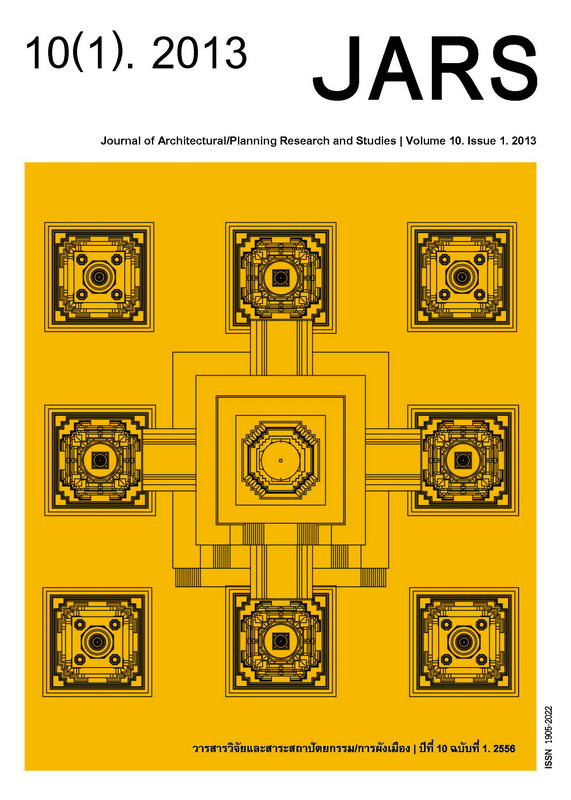A Comparative Study of Green Building Evaluation Standards: Identifying Major/Minor Emphasis on Environment, Resource and Energy Issues
Main Article Content
Abstract
Downloads
Article Details

This work is licensed under a Creative Commons Attribution-NonCommercial-NoDerivatives 4.0 International License.
All material is licensed under the terms of the Creative Commons Attribution 4.0 International (CC-BY-NC-ND 4.0) License, unless otherwise stated. As such, authors are free to share, copy, and redistribute the material in any medium or format. The authors must give appropriate credit, provide a link to the license, and indicate if changes were made. The authors may do so in any reasonable manner, but not in any way that suggests the licensor endorses you or your use. The authors may not use the material for commercial purposes. If the authors remix, transform, or build upon the material, they may not distribute the modified material, unless permission is obtained from JARS. Final, accepted versions of the paper may be posted on third party repositories, provided appropriate acknowledgement to the original source is clearly noted.
References
Adiwoso, N. S. A., Prasetyoadi & Perdana, S. (n.d.). Towards Indonesia sustainable future through sustainableฃ building and construction. Retrieved September 5, 2011, from http://www.mgbc.org.my/Resources/Day%202/GBC%20Indonesia%20Presentations/Country%20Paper%20-%20GBC%20Indonesia%20Presentation%20Paper.pdf
Attmann, O. (2010). Green architecture: Advanced technologies and materials. New York: McGraw-Hill.
BRE Global. (2011). BREEAM new construction, technical manual SD5073: 2.0. Retrieved September 25, 2011, from http://www.breeam.org/filelibrary/Technical%20Manuals/SD5073_BREEAM_2011_New_Construction_Technical_Guide_ISSUE_2_0.pdf
Building and Construction Authority. (2010). BCA green mark for new non-residential buildings, version NRB/4.0. Retrieved August 10, 2011, from http://bca.gov.sg/GreenMark/green_mark_criteria.html
Bunz, K. R., Henze, G. P. & Tiller, D. K. (2006). Survey of sustainable building design practices in North America, Europe, and Asia. Journal of Architectural Engineering, 33-62.
California Integrated Waste Management Board. (2000). Designing with vision: A technical manual for material choices in sustainable construction. California Environmental Protection Agency, California, CA, USA.
European Commission. (n.d.). Industrial innovation sustainable construction. Retrieved August 20, 2011, from http://ec.europa.eu/enterprise/policies/innovation/policy/lead-market-initiative/sustainable-construction/
GREEN BUILDING INDEX SDN BHD. (2011). Green building index: Non-Residential New Construction (NRNC) design reference guide and submission format version 1.05. Retrieved September 25, 2011, from http://www.greenbuildingindex.org/Resources/GBI%20Tools/GBI%20Design%20Reference%20Guide%20-%20Non-Residential%20New%20Construction%20(NRNC)%20V1.05.pdf
Green Building Council Indonesia. (2011). Greenship rating tools for new building, version 1.0. Retrieved September 25, 2011, from http://www.gbcindonesia.org
Ibn-Homaid, N. T. (2002). A comparative evaluation of construction and manufacturing materials management. International Journal of Project Management, 20, 263-270.
Institute for Building Environment and Energy Conservation [IBEC]. (2008). CASBEE for new construction. Retrieved September 25, 2011, from http://www.ibec.or.jp/CASBEE/english/download/CASBEENCe_2008manual.pdf 22-09-2554
Katharangsiporn, K. (2011, April 28). Painting your building green. Bangkok Post. Retrieved from http://www.asa.or.th/?q=node/108612
Kittiwararat, S. & Lertwattanaruk, P. (2012). การจัดการเพื่อลดเศษวัสดุก่อสร้างในงานสถาปัตยกรรมของบ้านพักอาศัยขนาดเล็ก [Strategies for construction waste reduction in small residential buildings]. Journal of Architectural/Planning Research and Studies, 9(2), 84-94.
Moavenzadeh, F. (1978). Construction industry in developing countries. World Development, 6(1), 97-116.
Mun, T. L. (2009, April 23). The Development of GBI Malaysia (GBI). Retrieved from http://www.greenbuildingindex.org/Resources/GBI%20Documents/20090423%20-%20The%20Development%20of%20GBI%20Malaysia.pdf
Natural Building Technologies [NBT]. (n.d.). Building environmental impact. Retrieved September 23, 2011, from http://www.natural-building.co.uk/environmental_impact.html
Smith, T. M., Fischlein, M., Su, S., & Huelman, P. (2006). Rating systems: A comparison of the LEED and green globes system in the US. Retrieved September 25, 2011, from http://http://www.thegbi.org/gbi/Green_Building_Rating_UofM.pdf
Thai Green Building Institute [TGBI]. (2010). เกณฑ์การประเมินความยั่งยืนทางพลังงานและสิ่งแวดล้อมไทย: สำหรับการก่อสร้างและปรับปรุงโครงการใหม่ [Thai’s rating of energy and environmental sustainability for new construction and major renovation]. Bangkok, Thailand: Author.
The U.S. Green Building Council [USGBC]. (2011). LEED 2009 for new construction and major renovations. Retrieved September 25, 2011, from http://www.usgbc.org/ShowFile.aspx?DocumentID=8868
Thirakomen, K. (2004) Sustainable building assessment. Journal of Architectural Research and Studies, 2, 3-21. Retrieved September 15, 2011, from http://www.ap.tu.ac.th/jars/download/jars/v2/01_Kecha%20Thirakomen.pdf
TN Sebake. (n.d.). An overview of green building rating tools. Retrieved September 25, 2011, from http://researchspace.csir.co.za/dspace/bitstream/10204/3515/1/Sebake_2009.pdf
United States Environmental Protection Agency. (2008). Lifecycle construction resource guide. Retrieved September 23, 2011, from http://www.epa.gov/region4/p2
Varodompun, V. (2009). Review article: Energy & environmental rating systems for measuring green building performances. Journal of Architectural/Planning Research and Studies, 6(1), 123-152.


